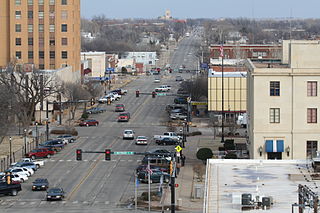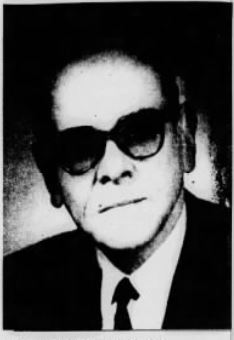Lincoln County

- St. Paul Baptist Church and Cemetery in Meeker; NRHP-listed
This list of cemeteries in Oklahoma includes currently operating, historical (closed for new interments), and defunct (graves abandoned or removed) cemeteries, columbaria, and mausolea which are historical and/or notable. It does not include pet cemeteries.
Smith Cemetery in Moore


Tulsa County is a county located in the U.S. state of Oklahoma. As of the 2020 census, the population was 669,279, making it the second-most populous county in the state, behind only Oklahoma County. Its county seat and largest city is Tulsa, the second-largest city in the state. Founded at statehood, in 1907, it was named after the previously established city of Tulsa. Before statehood, the area was part of both the Creek Nation and the Cooweescoowee District of Cherokee Nation in Indian Territory. Tulsa County is included in the Tulsa metropolitan statistical area. Tulsa County is notable for being the most densely populated county in the state. Tulsa County also ranks as having the highest income.

Enid is the ninth-largest city in the U.S. state of Oklahoma. It is the county seat of Garfield County. As of the 2020 census, the population was 51,308. Enid was founded during the opening of the Cherokee Outlet in the Land Run of 1893, and is named after Enid, a character in Alfred, Lord Tennyson's Idylls of the King. In 1991, the Oklahoma state legislature designated Enid the "purple martin capital of Oklahoma." Enid holds the nickname of "Queen Wheat City" and "Wheat Capital" of Oklahoma and the United States for its immense grain storage capacity, and has the third-largest grain storage capacity in the world.

Okmulgee is a city in the Tulsa metropolitan area and the county seat of Okmulgee County in Oklahoma, United States. The name is from the Muskogee word okimulgi, which means "boiling waters". The site was chosen because of the nearby rivers and springs. Okmulgee is 38 miles south of Tulsa and 13 miles north of Henryetta via US-75.
Fort Gibson is a town in Cherokee and Muskogee counties in the U.S. state of Oklahoma. The population was 3,814 as of the 2020 Census. It is the location of Fort Gibson Historical Site and Fort Gibson National Cemetery and is located near the end of the Cherokees' Trail of Tears at Tahlequah.

The St. Louis–San Francisco Railway, commonly known as the "Frisco", was a railroad that operated in the Midwest and South Central United States from 1876 to November 21, 1980. At the end of 1970, it operated 4,547 miles (7,318 km) of road on 6,574 miles (10,580 km) of track, not including subsidiaries Quanah, Acme and Pacific Railway and the Alabama, Tennessee and Northern Railroad; that year, it reported 12,795 million ton-miles of revenue freight and no passengers. In 1980 it was purchased by and absorbed into the Burlington Northern Railroad. Despite its name, it never came close to San Francisco.
Phillips Theological Seminary is a private seminary affiliated with the Christian Church and located in Tulsa, Oklahoma. It was established in 1906 and was originally a part of the now defunct Phillips University.

Fort Gibson is a historic military site next to the modern city of Fort Gibson, in Muskogee County Oklahoma. It guarded the American frontier in Indian Territory from 1824 to 1888. When it was constructed, the fort was farther west than any other military post in the United States. It formed part of the north–south chain of forts that was intended to maintain peace on the frontier of the American West and to protect the southwestern border of the Louisiana Purchase. The fort succeeded in its peacekeeping mission for more than 50 years, as no massacres or battles occurred there.

The Manhattan Construction Company is an American-owned construction company founded by Laurence H. Rooney in Chandler in Oklahoma Territory in 1896. Today, the firm operates under its parent company, Manhattan Construction Group with affiliates Cantera Concrete Co. and Manhattan Road & Bridge. Manhattan Construction Group is recognized by Engineering News-Record as a top general builder, green builder and bridge builder in the nation. In 2013 and 2012 Manhattan has received more than 50 industry honors for quality and safety. The company's services include "Builder-Driven Pre-Construction", construction management, general building, design-build and turn-key projects, and roads, bridges and civil works. The company works in the U.S., Mexico, Central America and the Caribbean. Not to be confused with Manhattan Construction of Durham Region.

The Oklahoma Historical Society (OHS) is an agency of the government of Oklahoma dedicated to promotion and preservation of Oklahoma's history and its people by collecting, interpreting, and disseminating knowledge and artifacts of Oklahoma. The mission of the OHS is to collect, preserve, and share the history and culture of the state of Oklahoma and its people.

This is a list of the National Register of Historic Places listings in Garfield County, Oklahoma.

John Duncan Forsyth was a Scottish-American architect who became prominent in Oklahoma. Based in Tulsa and working in a variety of styles, he was connected with a number of significant buildings around the state.

The Enid Cemetery is a cemetery in Enid, Oklahoma. Together with the Calvary Catholic Cemetery, it has been listed on the National Register of Historic Places since 1996. Opened in the 1890s, the two cemeteries were designed in the rural cemetery style. Only a portion of the Enid Cemetery contributes to the historical significance: the Original (1898), First (1918), Second (1920), and Evergreen (1923) additions. Together these encompass a 967 by 1,318-foot (402 m) area historical section.

George Winkler was an American architect who practiced in Pennsylvania, Florida and Oklahoma from 1903 to 1953.
The following is a timeline of the history of the city of Tulsa, Oklahoma, United States.
Walter T. Vahlberg was an architect based in Oklahoma. Several of his works are listed on the National Register of Historic Places (NRHP).

Leon Bishop Senter was an American architect who worked primarily in Oklahoma. Although not formally educated in architecture, he became Oklahoma's first licensed architect in 1925 and designed several buildings on the National Register of Historic Places.